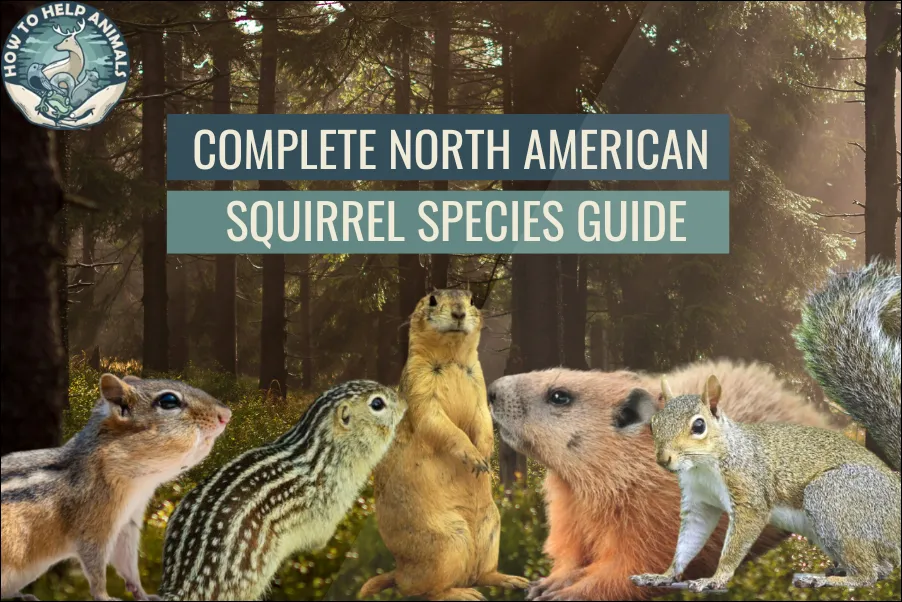
The morning sun filters through the oak canopy as a sleek gray form leaps effortlessly from branch to branch, its bushy tail acting as both rudder and parachute. You pause, wondering – is that an Eastern Gray Squirrel or perhaps its larger cousin, the Fox Squirrel? The difference could tell you everything from what foods it prefers to whether it’s native to your area.
North America hosts an incredible 65+ squirrel species, ranging from tiny chipmunks weighing less than an ounce to massive marmots tipping the scales at 18 pounds. This comprehensive guide covers every species across all three major groups – tree squirrels, ground squirrels, and flying squirrels – with detailed identification tips, behavior insights, and current conservation status.
Understanding North American Squirrel Diversity
The squirrel family (Sciuridae) represents one of the most successful mammalian groups on Earth, with North America serving as home to an extraordinary variety of species. Recent genetic studies have revolutionized our understanding of squirrel relationships, revealing that many traditional classifications were incorrect and leading to exciting new species discoveries as recently as 2017.
From the temperate rainforests of the Pacific Northwest to the desert Southwest, from Arctic tundra to tropical Mexican highlands, squirrels have adapted to virtually every habitat across the continent. Each species has evolved unique characteristics shaped by their environment – from the massive Fox Squirrels that spend more time on the ground to the gliding Flying Squirrels that never touch it.
Understanding these differences isn’t just academic curiosity. Proper identification helps wildlife watchers appreciate the remarkable diversity in their backyards, assists property owners in addressing conflicts humanely, and supports conservation efforts for endangered species like the Mount Graham Red Squirrel or Utah Prairie Dog.
🐿️ Quick Species Navigation
🌳 Tree Squirrels
✈️ Flying Squirrels
🏔️ Ground Squirrels
🌾 Prairie Dogs
Tree Squirrels: The Acrobats of the Canopy
Eastern Gray Squirrel (Sciurus carolinensis)
Size & Appearance: 16-20 inches total length, 400-600 grams. Gray fur with white belly, large bushy tail with frosted appearance from white-tipped guard hairs.
Distinctive Features: Medium size with predominantly gray coloration, though melanistic (black) forms increase with latitude – reaching 18% of populations in some northern areas due to better heat retention in cold climates.
Range & Habitat: Originally native to eastern deciduous forests from southern Canada to northern Florida, now established throughout the continent through introductions. Thrives in mature hardwood forests, urban parks, and suburban neighborhoods with large trees.
Behavior & Ecology: Highly adaptable and intelligent, building leafy “dreys” in tree branches or utilizing natural cavities. Practices scatter-hoarding, burying thousands of nuts individually and relocating about 75% through spatial memory. Active year-round with peak activity in early morning and late afternoon.
Conservation Status: Least Concern, but considered invasive in many western regions where they outcompete native species.
Similar Species: Easily confused with Western Gray Squirrel (larger, pure gray without brownish tones) and Fox Squirrel (larger, more orange-brown coloration).
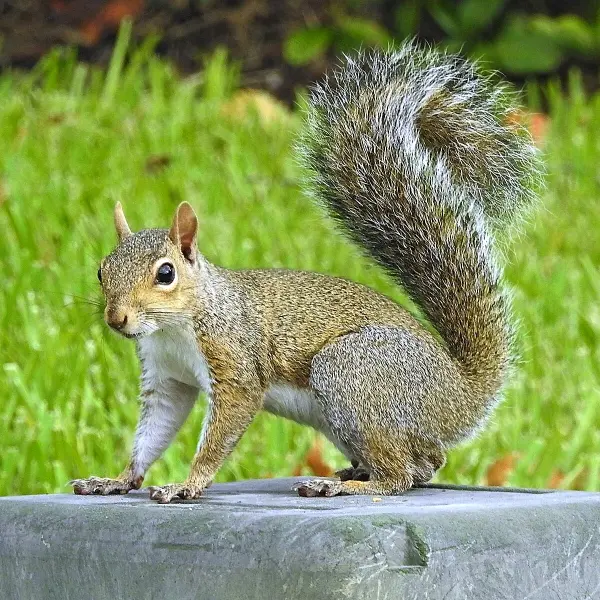
Western Gray Squirrel (Sciurus griseus)
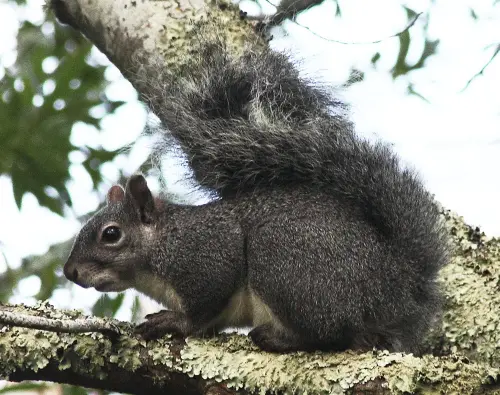
Size & Appearance: 20-24 inches total length, 450-900 grams. Pure steel-gray back with brilliant white belly, proportionally longer tail than Eastern Gray.
Distinctive Features: Largest native tree squirrel in many western areas, pure gray coloration without the brownish wash of Eastern Grays. Prominent ear tufts in winter, less social than Eastern cousins.
Range & Habitat: Pacific Coast from Washington to Baja California, extending inland through oak woodlands and mixed coniferous forests. Prefers areas with large oaks and pines.
Behavior & Ecology: More arboreal than Eastern Grays, rarely venturing far from trees. Builds large stick nests lined with shredded bark. Primary food sources include acorns, pine nuts, and fungi.
Conservation Status: Threatened in Washington State with only 400-1,400 individuals remaining. Habitat loss and competition from Eastern Grays pose significant threats.
Similar Species: Distinguished from Eastern Gray Squirrel by larger size, pure gray coloration, and white belly extending onto flanks.
Fox Squirrel (Sciurus niger)
Size & Appearance: 18-28 inches total length, 500-1,000 grams (occasionally up to 1,400g). Highly variable coloration with three main forms: southeastern (gray with black head and feet), northern (rusty brown), and western/Texas (rust and gray mixed).
Distinctive Features: Largest tree squirrel in North America, often twice the weight of Gray Squirrels. Spends more time foraging on the ground than other tree squirrels. Distinctive orange-brown tail fringe in most populations.
Range & Habitat: Originally south-central and southeastern US, now widely introduced westward. Prefers open woodlands, forest edges, and parklands rather than dense forests.
Behavior & Ecology: More terrestrial than other tree squirrels, often seen crossing open areas between tree groves. Builds larger nests than Gray Squirrels, using more substantial branches. Known for “fake burying” nuts to confuse potential thieves.
Conservation Status: Generally stable, but the Delmarva Peninsula subspecies was successfully removed from the Endangered Species List in 2015 after a remarkable recovery.
Similar Species: Distinguished by large size, rusty coloration, and more terrestrial habits. Some confusion possible with large Eastern Gray Squirrels in transition zones.
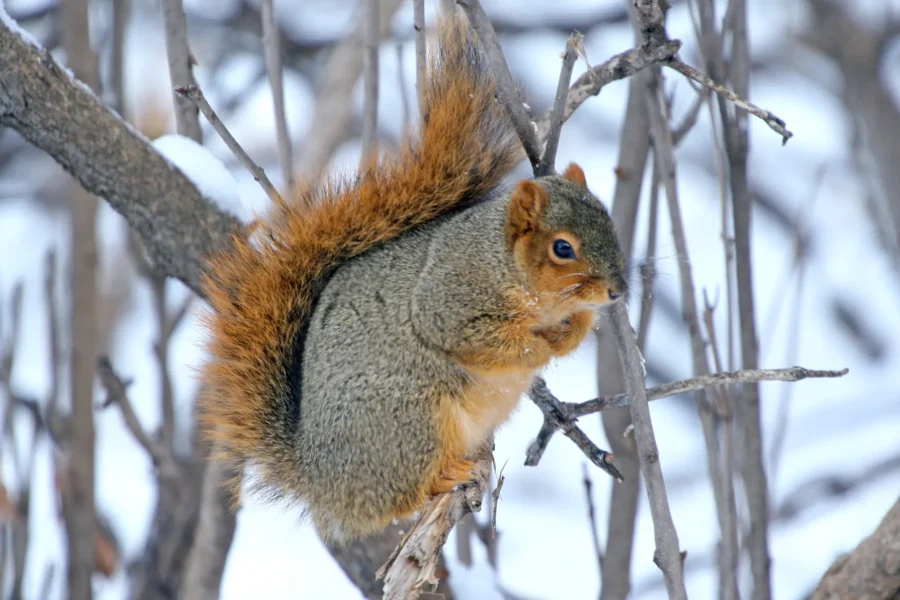
American Red Squirrel (Tamiasciurus hudsonicus)
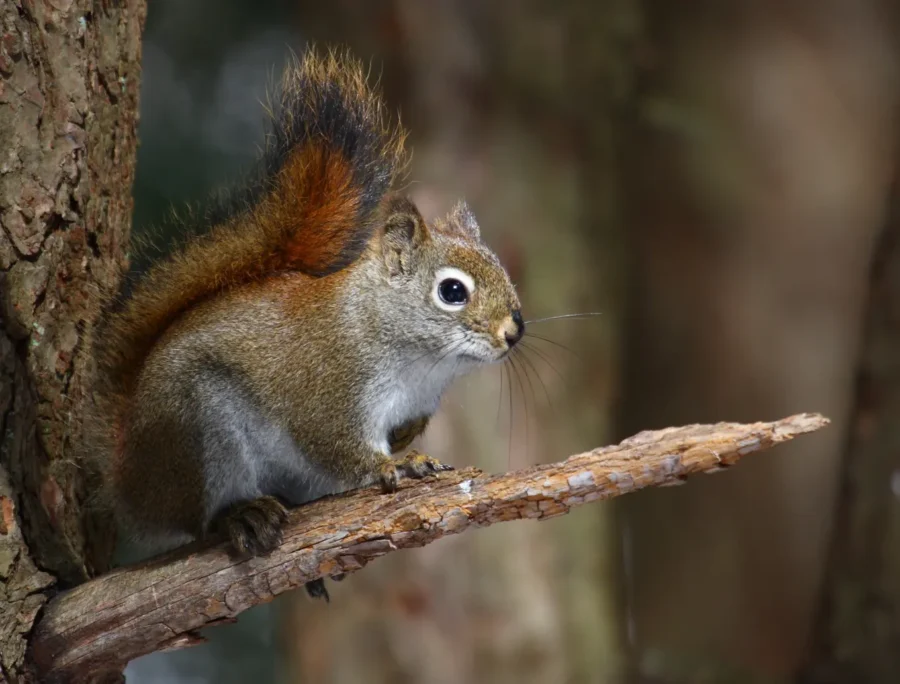
Size & Appearance: 11-14 inches total length, 200-250 grams. Rusty red back with white belly, prominent white eye ring. Summer coat brighter red than winter coat.
Distinctive Features: Smallest North American tree squirrel, highly territorial with distinctive chattering alarm calls. Prominent ear tufts in winter, lost in summer molt.
Range & Habitat: Boreal and montane coniferous forests from Alaska to Newfoundland, south through Rocky Mountains and Appalachians. Strongly associated with spruce, fir, and pine forests.
Behavior & Ecology: Unlike other squirrels, creates centralized caches (middens) containing thousands of pine cones. Extremely territorial, with individual territories as small as 1-2 acres defended vigorously. Peak activity in early morning.
Conservation Status: Generally stable, but the Mount Graham subspecies remains federally endangered with recent population increase from 144 to 233 individuals (2023-2025).
Similar Species: Could be confused with Douglas Squirrel in overlap zones, but Red Squirrels lack the dark back stripe and orange underside of Douglas Squirrels.
Douglas Squirrel (Tamiasciurus douglasii)
Size & Appearance: 12-14 inches total length, 150-300 grams. Dark gray-brown back with bright orange-yellow underside, separated by distinct dark stripe along flanks.
Distinctive Features: Pacific Northwest endemic, also called “Chickaree.” Prominent orange belly contrasts sharply with dark back. Summer and winter coats notably different.
Range & Habitat: Coastal and Cascade forests from British Columbia to northern California. Strongly associated with old-growth and mature second-growth coniferous forests.
Behavior & Ecology: Similar territorial behavior to Red Squirrels but adapted to different forest types. Creates impressive cone caches and plays crucial role in dispersing fungal spores that form symbiotic relationships with forest trees.
Conservation Status: Declining in many areas due to old-growth forest loss, but not yet formally listed.
Similar Species: Easily distinguished from Red Squirrel by orange underside and dark flank stripe. No other species in its range has similar coloration.
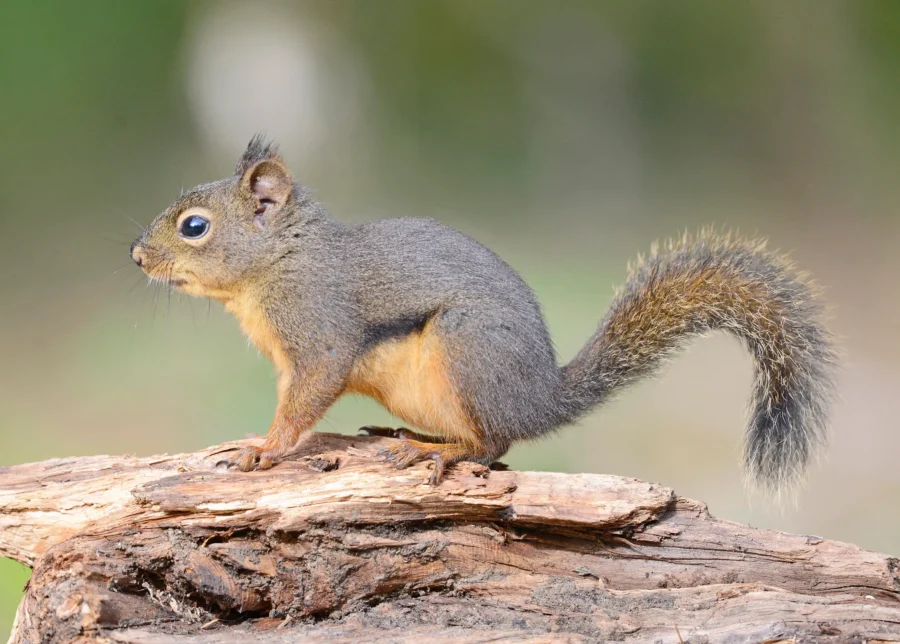
Abert’s Squirrel (Sciurus aberti)

Size & Appearance: 18-23 inches total length, 500-650 grams. Gray body with distinctive black ear tufts (most prominent in winter), white underside, and either gray tail with white fringe or completely white tail.
Distinctive Features: Iconic ear tufts make this species unmistakable. Kaibab subspecies features striking black body with pure white tail. Ear tufts molted and regrown annually.
Range & Habitat: Southwestern US and northwestern Mexico, exclusively in ponderosa pine forests between 5,500-9,000 feet elevation.
Behavior & Ecology: Completely dependent on ponderosa pines for food and shelter. Feeds on inner bark, twigs, seeds, and fungi. Population density directly correlates with ponderosa pine health and abundance.
Conservation Status: Sensitive to habitat changes but currently stable. Kaibab subspecies confined to small area north of Grand Canyon.
Similar Species: Unmistakable within its range due to distinctive ear tufts and ponderosa pine association.
Mexican Fox Squirrel (Sciurus nayaritensis)
Size & Appearance: 20-25 inches total length, 600-800 grams. Grizzled brown and gray body with distinctive black or charcoal-colored tail, white or cream belly.
Distinctive Features: Large size and dark tail distinguish this species. Three recognized subspecies, including the Arizona endemic S. n. chiricahuae found only in the Chiricahua Mountains.
Range & Habitat: Mountains of western Mexico extending into southeastern Arizona and southwestern New Mexico. Prefers oak-pine forests at 4,000-8,000 feet elevation.
Behavior & Ecology: More secretive than other tree squirrels, often difficult to observe. Builds nests in oak trees and feeds primarily on acorns, pine nuts, and fungi.
Conservation Status: Rare in the United States portion of range, with possibly fewer than 1,000 individuals north of Mexico.
Similar Species: Could be confused with Fox Squirrel, but darker tail and different habitat preferences aid identification.
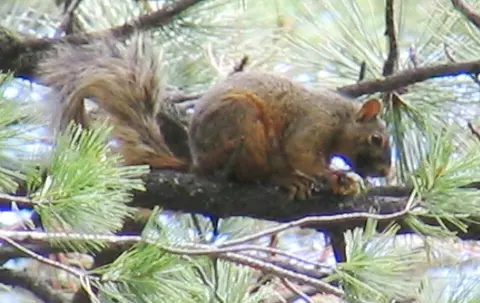
Flying Squirrels: Masters of the Night Sky
Northern Flying Squirrel (Glaucomys sabrinus)

Size & Appearance: 10-12 inches total length, 75-150 grams. Silky gray-brown fur above, grayish-white below with gray at base of belly hairs. Large black eyes, loose skin membrane (patagium) between legs.
Distinctive Features: Nocturnal gliding ability up to 150 feet, bright pink fluorescence under UV light (discovered 2019). Belly fur gray at base distinguishes from Southern Flying Squirrel.
Range & Habitat: Boreal and montane coniferous forests from Alaska to Nova Scotia, south through western mountains and isolated populations in Appalachians.
Behavior & Ecology: Strictly nocturnal, gliding between trees using stretched patagium. Feeds primarily on fungi, lichens, tree sap, and cached nuts. Social in winter, with multiple individuals sharing nest cavities.
Conservation Status: Two subspecies federally endangered (Carolina and formerly West Virginia populations), but most populations stable.
Similar Species: Distinguished from Southern Flying Squirrel by larger size, grayer coloration, and belly fur gray at base.
Southern Flying Squirrel (Glaucomys volans)
Size & Appearance: 8-10 inches total length, 50-85 grams. Silky gray-brown above, white below with white hair to base. Proportionally larger eyes than Northern Flying Squirrel.
Distinctive Features: Smallest North American squirrel, also fluoresces pink under UV light. Pure white belly fur distinguishes from Northern species. Can transmit sylvatic typhus (39 documented cases).
Range & Habitat: Eastern deciduous forests from southern Canada to Florida, west to Great Plains. Prefers mature hardwood forests with oak and hickory.
Behavior & Ecology: Highly social, especially in winter when up to 20 individuals may share a nest cavity. Glides up to 80 feet, feeding primarily on nuts, seeds, bark, and cached acorns.
Conservation Status: Expanding northward with climate change but stable throughout most of range.
Similar Species: Smaller than Northern Flying Squirrel with pure white (not gray-based) belly fur.

Humboldt’s Flying Squirrel (Glaucomys oregonensis)

Size & Appearance: 10-11 inches total length, 60-140 grams. Virtually identical to Northern Flying Squirrel in all external characteristics – distinguishable only through genetic analysis.
Distinctive Features: Third North American flying squirrel species, recognized through 2017 genetic study. Also fluoresces pink under UV light. Cannot be identified morphologically from Northern Flying Squirrel.
Range & Habitat: Pacific Coast from British Columbia to California, primarily in coastal coniferous forests. San Bernardino Mountains subspecies critically imperiled.
Behavior & Ecology: Presumably similar to Northern Flying Squirrel, but ecological differences still being studied. May prefer different microhabitats or food sources.
Conservation Status: Recently recognized species with conservation status still being assessed. Southern California populations critically endangered.
Similar Species: Impossible to distinguish from Northern Flying Squirrel without genetic testing.
Ground Squirrels: The Terrestrial Specialists
Eastern Chipmunk (Tamias striatus)
Size & Appearance: 8-10 inches total length, 70-120 grams. Reddish-brown with five dark stripes alternating with light stripes down back, white belly, bushy tail with dark tip.
Distinctive Features: Only member of genus Tamias (all other chipmunks belong to Neotamias). Larger than western chipmunks with more prominent stripes.
Range & Habitat: Eastern deciduous forests from southern Canada to northern Georgia, west to North Dakota. Prefers mature forests with abundant ground cover.
Behavior & Ecology: Excellent climber despite being classified as ground squirrel. Creates extensive burrow systems with multiple chambers for storage and nesting. True hibernator, unlike tree squirrels.
Conservation Status: Stable throughout range, expanding westward in some areas.
Similar Species: Larger and more distinctly striped than any western chipmunk species.

Least Chipmunk (Neotamias minimus)
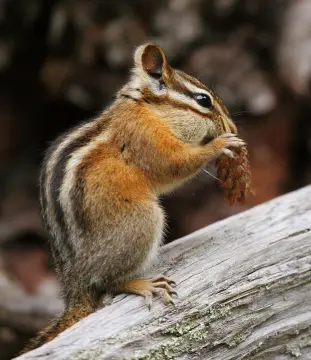
Size & Appearance: 7-9 inches total length, 35-50 grams. Yellowish-gray with five dark and four light stripes, proportionally longer tail than other chipmunks.
Distinctive Features: Smallest chipmunk, distinctive habit of running with tail held vertically. Color varies geographically from yellowish to grayish.
Range & Habitat: Most widespread western chipmunk, from Yukon to New Mexico. Adaptable to various habitats from sagebrush to high mountains.
Behavior & Ecology: Most active during midday hours, unlike other chipmunks. Excellent climber, often foraging in trees. Hibernates 7-8 months in northern areas.
Conservation Status: Stable and widespread.
Similar Species: Smaller size and tail-up running posture distinguish from other chipmunks.
Yellow-pine Chipmunk (Neotamias amoenus)
Size & Appearance: 8-10 inches total length, 45-65 grams. Bright brown with distinct black and white stripes, reddish sides, grayish head.
Distinctive Features: Brightest colored chipmunk, associated with yellow pine forests. Clear black and white facial stripes.
Range & Habitat: Pacific Northwest mountains in coniferous forests, particularly areas with ponderosa and lodgepole pine.
Behavior & Ecology: Semi-arboreal, spending significant time in trees. Creates caches in hollow logs and tree cavities. Active 5-6 months per year.
Conservation Status: Stable within appropriate habitat.
Similar Species: Brighter coloration and habitat preferences distinguish from other western chipmunks.
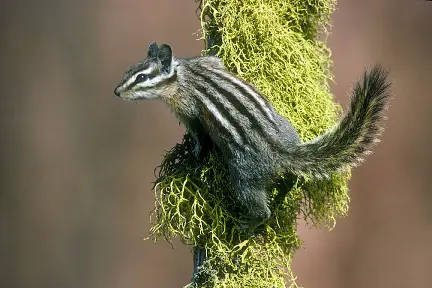
California Ground Squirrel (Otospermophilus beecheyi)

Size & Appearance: 14-18 inches total length, 280-600 grams. Mottled gray-brown with white-speckled back, whitish shoulders, bushy tail with black tip.
Distinctive Features: Medium-large ground squirrel with distinctive anti-snake behaviors. Recent studies documented carnivorous behavior – actively hunting voles.
Range & Habitat: California and parts of Oregon, Nevada, and Baja California. Adaptable to various habitats from coastal areas to inland valleys.
Behavior & Ecology: Highly social with complex communication system. Demonstrates remarkable anti-predator behaviors including immunity to certain snake venoms and mob attacks on snakes. Colonial burrow systems.
Conservation Status: Stable and common, sometimes considered agricultural pest.
Similar Species: Size and habitat distinguish from smaller chipmunks and larger marmots.
Thirteen-lined Ground Squirrel (Ictidomys tridecemlineatus)
Size & Appearance: 9-12 inches total length, 110-300 grams. Brown with 13 alternating light and dark stripes (some broken into spots), white belly.
Distinctive Features: Distinctive stripe pattern with exactly 13 lines. Range expanding eastward with habitat changes and agriculture.
Range & Habitat: Great Plains from Canada to Texas, expanding eastward into Midwest. Prefers short-grass prairies and agricultural areas.
Behavior & Ecology: True hibernator, spending up to 8 months underground. Feeds primarily on seeds, green vegetation, and some insects. Solitary except during breeding season.
Conservation Status: Stable and expanding in some areas.
Similar Species: Unique stripe pattern prevents confusion with other species.
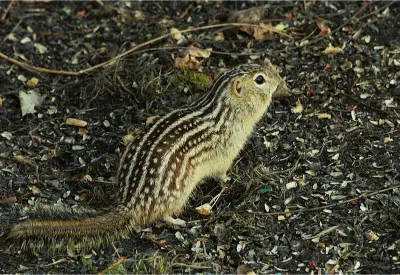
Arctic Ground Squirrel (Urocitellus parryii)
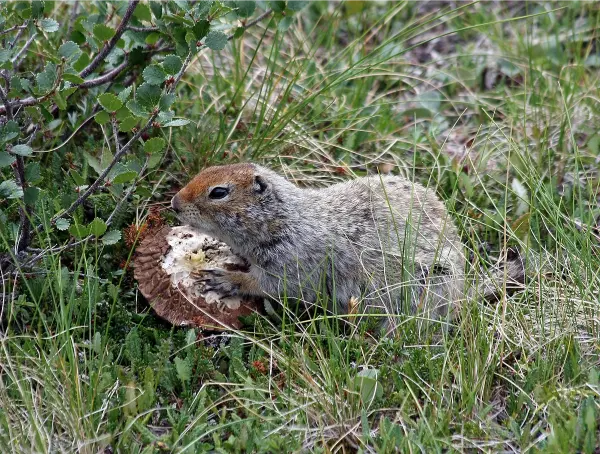
Size & Appearance: 13-20 inches total length, 500-1,500 grams. Variable brown to cinnamon with white-spotted back, reddish underparts in summer.
Distinctive Features: Northernmost squirrel, capable of surviving Arctic conditions. Dramatic seasonal color changes from brown summer coat to gray winter coat.
Range & Habitat: Alaska, northern Canada, and eastern Siberia. Tundra and northern forest habitats, often along rivers and lakeshores.
Behavior & Ecology: Most extreme hibernator, lowering body temperature below freezing. Colonial burrow systems in permafrost. Crucial food source for Arctic predators.
Conservation Status: Stable but potentially vulnerable to climate change.
Similar Species: No other ground squirrels in most of range; size distinguishes from smaller Arctic mammals.
Prairie Dogs: The Ecosystem Engineers
Black-tailed Prairie Dog (Cynomys ludovicianus)
Size & Appearance: 14-16 inches total length, 700-1,400 grams. Buff to brown with black-tipped tail, robust build with short legs.
Distinctive Features: Largest prairie dog, complex social structure with “coteries” and sophisticated vocal communication system with regional dialects.
Range & Habitat: Great Plains from southern Canada to northern Mexico. Short-grass prairie with deep, well-drained soils.
Behavior & Ecology: Keystone species creating habitat for over 200 other species. Extensive burrow systems can extend 100+ feet underground. Complex social behaviors include “jump-yip” displays and sentinel behavior.
Conservation Status: Significant population declines due to habitat loss and plague. Considered keystone species requiring conservation attention.
Similar Species: Black tail tip distinguishes from white-tailed species.
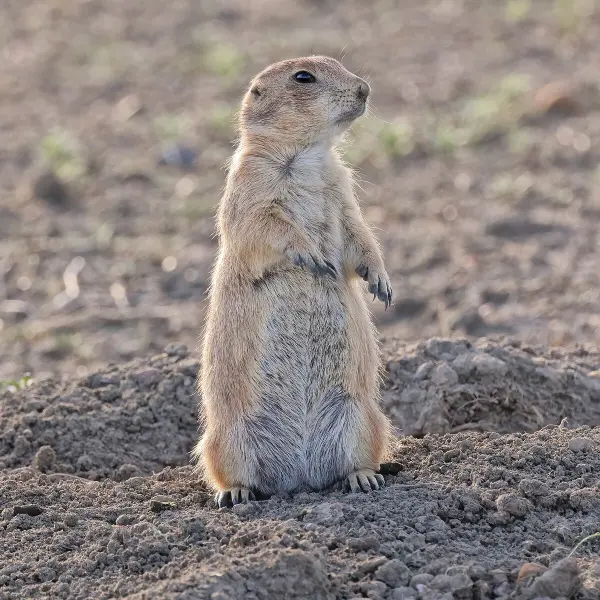
White-tailed Prairie Dog (Cynomys leucurus)
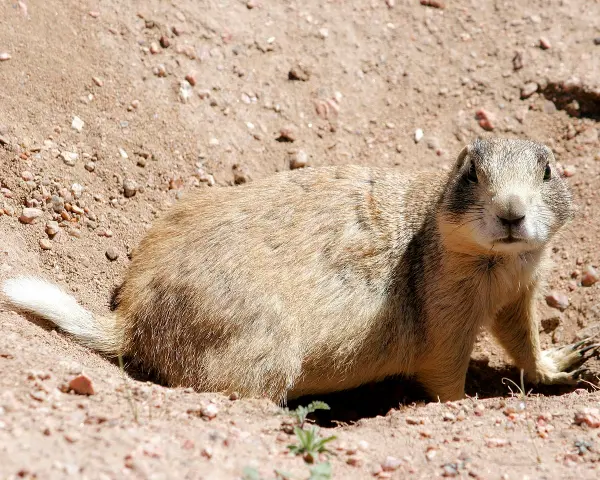
Size & Appearance: 13-15 inches total length, 800-1,700 grams. Brown to buff with white-tipped tail, slightly smaller than Black-tailed Prairie Dog.
Distinctive Features: White tail tip, higher elevation habitat, and less social than Black-tailed Prairie Dog. True hibernators unlike black-tailed species.
Range & Habitat: High-elevation grasslands and sagebrush steppes in Wyoming, Colorado, Utah, and Montana above 5,000 feet.
Behavior & Ecology: Less colonial than black-tailed species, hibernating 6-7 months. Burrows simpler and less extensive than black-tailed prairie dogs.
Conservation Status: More stable than black-tailed species but still declining in some areas.
Similar Species: White tail tip and high-elevation habitat distinguish from Black-tailed Prairie Dog.
Utah Prairie Dog (Cynomys parvidens)
Size & Appearance: 12-14 inches total length, 500-1,400 grams. Smallest prairie dog, cinnamon-brown with white-tipped tail and distinctive facial markings.
Distinctive Features: Smallest prairie dog species, endemic to Utah. Dark facial patches distinctive among prairie dogs.
Range & Habitat: Endemic to south-central Utah in sagebrush and pinyon-juniper habitats between 5,000-9,000 feet elevation.
Behavior & Ecology: Intermediate social structure between black-tailed and white-tailed species. Hibernates 3-6 months depending on elevation.
Conservation Status: Remarkable recovery success – increased from 3,300 in 1970s to 69,537 in 2024 under Endangered Species Act protection.
Similar Species: Smallest size and Utah-only range prevent confusion with other prairie dogs.
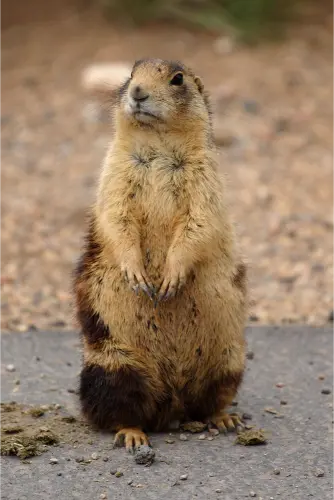
Mexican Prairie Dog (Cynomys mexicanus)

Size & Appearance: 14-16 inches total length, 900-1,500 grams. Similar to Black-tailed Prairie Dog but with subtle differences in coloration and cranial features.
Distinctive Features: Most endangered prairie dog, endemic to small area of northeastern Mexico. Slight differences in skull structure distinguish from Black-tailed Prairie Dog.
Range & Habitat: Restricted to small area of Coahuila, Mexico. Grasslands and agricultural areas.
Behavior & Ecology: Similar social structure to Black-tailed Prairie Dog but adapted to different plant communities and elevation.
Conservation Status: Endangered with 62% habitat loss and population fragmentation.
Similar Species: Range and subtle morphological differences distinguish from Black-tailed Prairie Dog.
Gunnison’s Prairie Dog (Cynomys gunnisoni)
Size & Appearance: 12-15 inches total length, 600-1,200 grams. Gray-brown with white-tipped tail, distinguished by unique vocalizations.
Distinctive Features: Complex vocal communication with specific calls for different predator types. Four distinct subspecies with different conservation concerns.
Range & Habitat: Colorado Plateau region including Colorado, Utah, Arizona, and New Mexico. High-elevation grasslands and meadows.
Behavior & Ecology: Intermediate social structure, hibernating 7-8 months. Less colonial than Black-tailed but more social than White-tailed Prairie Dogs.
Conservation Status: Some subspecies stable, but Utah subspecies listed as endangered with critically small populations.
Similar Species: Range and vocalizations help distinguish from other prairie dog species.
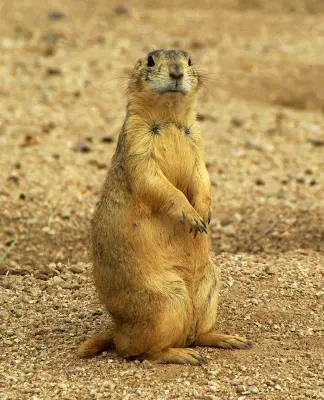
Marmots: The Giants of the Squirrel World
Hoary Marmot (Marmota caligata)
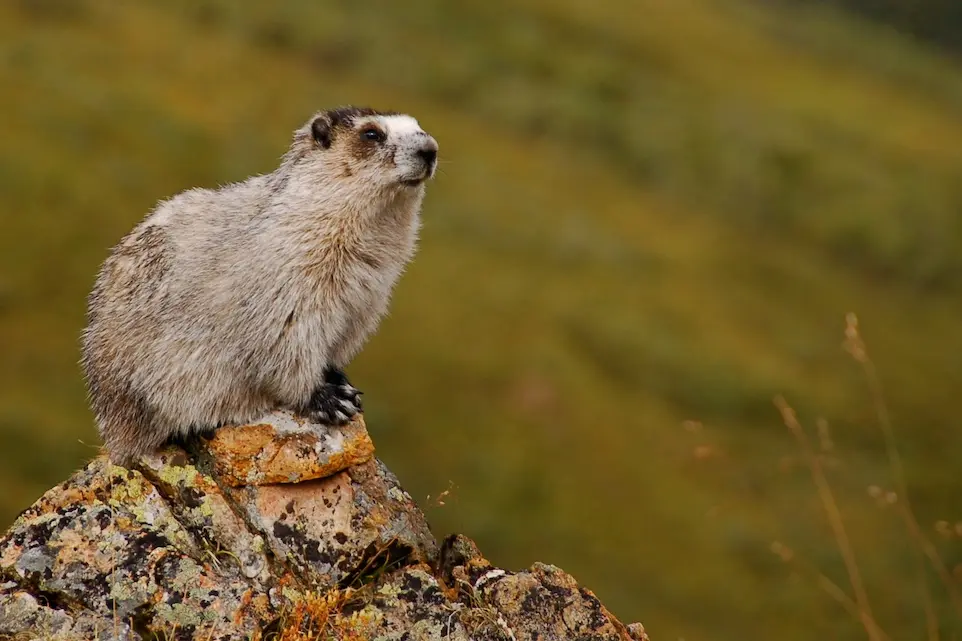
Size & Appearance: 18-28 inches total length, 5-13.5 kg. Largest North American ground squirrel, grizzled gray and white fur with black and white facial markings.
Distinctive Features: Massive size and distinctive whistling calls earning the nickname “whistle pig.” Sexual dimorphism with males significantly larger than females.
Range & Habitat: Mountain regions of Alaska, western Canada, and northwestern US. Alpine and subalpine meadows above treeline.
Behavior & Ecology: Colonial with family groups hibernating together 6-8 months. Sentinel behavior with individuals posting as lookouts while others feed.
Conservation Status: Stable but potentially vulnerable to climate change affecting alpine habitats.
Similar Species: Massive size prevents confusion with other species in range.
Yellow-bellied Marmot (Marmota flaviventris)
Size & Appearance: 16-24 inches total length, 2-6 kg. Brown back with yellowish belly, distinctive facial pattern with light patches around eyes.
Distinctive Features: Classic “groundhog” appearance but adapted to mountainous regions. Distinctive yellow belly coloration.
Range & Habitat: Western mountains from British Columbia to New Mexico. Rocky areas, talus slopes, and alpine meadows.
Behavior & Ecology: Colonial with complex social hierarchy. Hibernates 6-8 months, emerging to mate immediately upon waking. Primarily vegetarian.
Conservation Status: Stable throughout most of range.
Similar Species: Yellow belly and mountain habitat distinguish from other marmots.
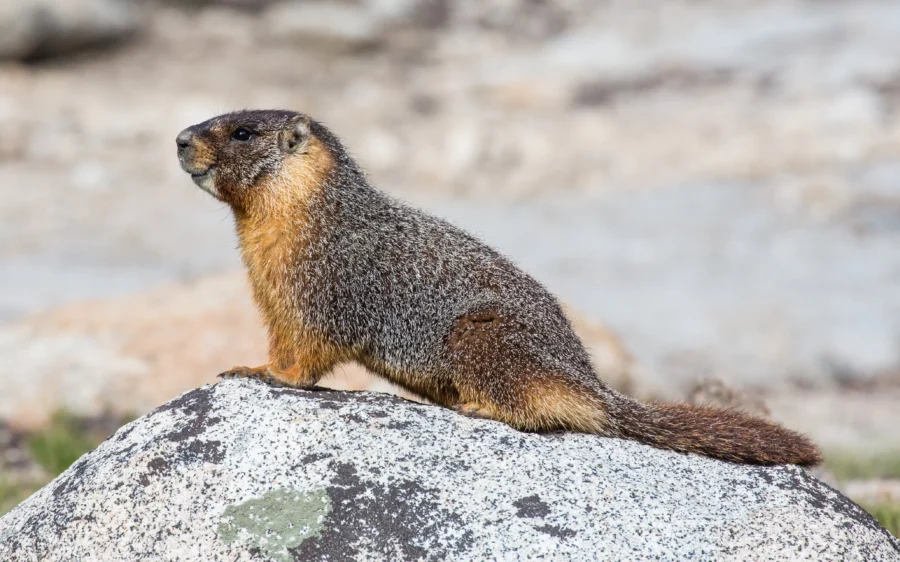
Olympic Marmot (Marmota olympus)
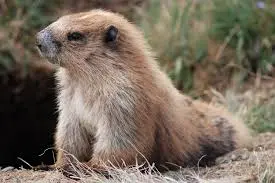
Size & Appearance: 18-25 inches total length, 3-8 kg. Brown fur with grizzled appearance, white patches on face, endemic to Olympic Peninsula.
Distinctive Features: Endemic to Olympic Mountains, Washington. Only marmot species in its range, making identification straightforward.
Range & Habitat: Olympic Peninsula only, in alpine and subalpine meadows above 4,000 feet elevation.
Behavior & Ecology: Social structure similar to other marmots but adapted to maritime climate of Olympics. Hibernates 7-8 months due to harsh winters.
Conservation Status: Vulnerable due to extremely limited range and climate change threats to alpine habitat.
Similar Species: Only marmot in Olympic Peninsula range.
Vancouver Island Marmot (Marmota vancouverensis)
Size & Appearance: 16-20 inches total length, 3-7 kg. Chocolate brown with white patches on nose, chin, and forehead. Distinctive among marmots for dark coloration.
Distinctive Features: World’s most endangered marmot and one of conservation’s greatest success stories. Dark brown coloration unique among North American marmots.
Range & Habitat: Endemic to Vancouver Island, British Columbia. Mountain meadows and clearcuts between 1,000-1,500 meters elevation.
Behavior & Ecology: Colonial with family groups, hibernating 7 months. Adapted to unique Vancouver Island ecosystem.
Conservation Status: Incredible recovery from 21 individuals in 2003 to over 250 through intensive captive breeding and reintroduction program.
Similar Species: Dark coloration and Vancouver Island range make identification certain.

Woodchuck (Marmota monax)
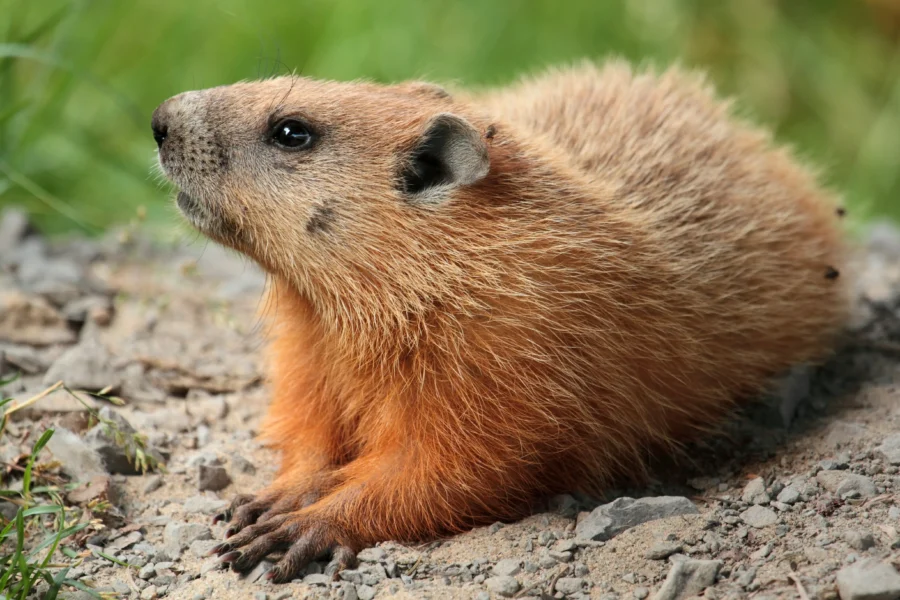
Size & Appearance: 16-24 inches total length, 2-6 kg. Brown to gray-brown fur, robust build with short legs, bushy tail.
Distinctive Features: Most widespread marmot, famous for Groundhog Day folklore. Also called groundhog, most likely marmot to be encountered by general public.
Range & Habitat: Eastern North America from Canada to Alabama, west to Great Plains. Adaptable to various habitats including forests, fields, and suburban areas.
Behavior & Ecology: Less social than western marmots, typically solitary except during breeding season. Hibernates 3-6 months depending on latitude.
Conservation Status: Stable and common, sometimes considered agricultural pest.
Similar Species: Range and habitat preferences distinguish from western marmot species.
Regional Variations and Subspecies
Color Morphs and Genetic Variations
Several squirrel species exhibit remarkable color variations that can confuse identification. Eastern Gray Squirrels show melanistic (black) forms that increase with latitude, reaching 18% of populations in some northern areas. This melanism results from a single gene mutation that provides better heat retention in cold climates.
Fox Squirrels display three distinct color morphs: the southeastern form with gray body and black head, the northern form with overall rusty coloration, and the western/Texas form showing mixed rust and gray patterns. These variations reflect adaptation to different habitats and selection pressures.
Subspecies of Conservation Concern
Many squirrel species include subspecies with distinct conservation needs. The Delmarva Peninsula Fox Squirrel (S. n. cinereus) was successfully removed from the Endangered Species List in 2015 after population recovery from fewer than 10,000 to over 20,000 individuals.
The Mount Graham Red Squirrel (T. h. grahamensis) remains federally endangered but shows encouraging population growth from 144 to 233 individuals between 2023-2025. This subspecies exists only on Mount Graham in Arizona and requires specific mixed-conifer habitat.
Identification Tips for Wildlife Watchers
Size Comparison Guide
Tiny (under 100g): Least Chipmunk, Southern Flying Squirrel Small (100-300g): Most chipmunks, American Red Squirrel, Douglas Squirrel, Northern Flying Squirrel Medium (300-700g): Eastern Gray Squirrel, Western Gray Squirrel, California Ground Squirrel Large (700g-1.5kg): Fox Squirrel, Arctic Ground Squirrel, most prairie dogs Massive (over 1.5kg): Large Fox Squirrels, all marmots
Behavioral Identification Clues
Tail position: Chipmunks run with tails vertical, tree squirrels curve tails over backs, ground squirrels hold tails low.
Activity patterns: Flying squirrels strictly nocturnal, most others diurnal with peak activity early morning and late afternoon.
Habitat preferences: Tree squirrels rarely venture far from trees, ground squirrels comfortable in open areas, prairie dogs create extensive burrow systems.
Alarm behaviors: Red and Douglas squirrels chatter aggressively, prairie dogs have complex vocal warnings, chipmunks give high-pitched chips.
Seasonal Identification Considerations
Many species undergo seasonal changes that affect identification:
- Ear tufts: Abert’s Squirrels develop prominent ear tufts in winter, lost during summer molt
- Color changes: Arctic Ground Squirrels shift from brown summer coats to gray winter coats
- Activity levels: Hibernating species disappear entirely during winter months
- Molting patterns: Flying squirrels appear larger and fluffier in winter coats
Conservation Status and Recent Discoveries
Recent Scientific Breakthroughs
The past decade has brought remarkable discoveries about North American squirrels. In 2017, genetic analysis revealed that Pacific Coast flying squirrels represent a distinct species – Humboldt’s Flying Squirrel – that cannot be distinguished morphologically from Northern Flying Squirrels.
Perhaps even more surprising, 2019 research discovered that all three North American flying squirrel species fluoresce bright pink under ultraviolet light, making them the only known fluorescent mammals besides some opossums. The evolutionary purpose of this fluorescence remains a mystery.
Behavioral studies have documented carnivorous behavior in California Ground Squirrels, with 42% of observed individuals actively hunting and killing voles. This challenges traditional understanding of squirrels as primarily vegetarian.
Conservation Success Stories
Several squirrel recovery programs demonstrate conservation’s potential. The Utah Prairie Dog population has increased from 3,300 individuals in the 1970s to 69,537 in 2024 under Endangered Species Act protection. Similarly, the Vancouver Island Marmot recovered from just 21 individuals in 2003 to over 250 through intensive captive breeding programs.
The Mount Graham Red Squirrel population increased 62% from 2023 to 2025, offering hope for this critically endangered subspecies. These successes show that targeted conservation efforts can bring species back from the brink of extinction.
Current Conservation Challenges
Climate change poses increasing threats to many squirrel species, particularly those with limited ranges or specific habitat requirements. Alpine species like Olympic Marmots face shrinking habitat as treelines advance upward. Flying squirrels may lose old-growth forest dependencies as logging and development continue.
Urban expansion affects many species differently – some like Eastern Gray Squirrels thrive in human-modified landscapes, while others like Western Gray Squirrels struggle with habitat fragmentation and competition from introduced species.
Using This Guide for Identification
When identifying squirrels in the field, follow this systematic approach:
- Size assessment: Compare to known objects (squirrel vs cat vs small dog)
- Habitat evaluation: Forest vs grassland vs urban vs alpine
- Behavior observation: Arboreal vs terrestrial, social vs solitary
- Physical characteristics: Color patterns, tail features, distinctive markings
- Geographic range: Eliminate species not found in your area
- Seasonal considerations: Account for molting, hibernation, breeding plumage
Remember that young animals may not show adult characteristics, and individual variation exists within species. When in doubt, photograph the animal and consult local wildlife experts or citizen science platforms like iNaturalist for identification assistance.
Contributing to Squirrel Research
Wildlife watchers can contribute valuable data to ongoing squirrel research through citizen science projects. Project Squirrel studies urban squirrel ecology and behavior, while SquirrelMapper documents distribution patterns. iNaturalist hosts over 500,000 squirrel observations that help scientists track population trends and range changes.
Reporting unusual behaviors, color variations, or species in unexpected locations can contribute to scientific understanding. Climate change and urban expansion are rapidly changing squirrel distributions, making current observations particularly valuable for future conservation planning.
The remarkable diversity of North American squirrels reflects millions of years of evolution and adaptation to diverse environments. From the mighty Hoary Marmots of Alaska’s peaks to the tiny chipmunks of desert canyons, each species represents a unique solution to survival challenges. Understanding and protecting this diversity ensures future generations can experience the joy of watching these remarkable animals thrive in their natural habitats.













